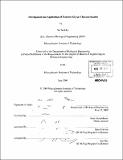Development and application of tools for glycan characterization
Author(s)
Beckley, Nia (Nia S.)
DownloadFull printable version (17.25Mb)
Alternative title
Tools for glycan characterization
Development and application of tools for glycan analysis
Other Contributors
Massachusetts Institute of Technology. Dept. of Biological Engineering.
Advisor
Ram Sasisekharan.
Terms of use
Metadata
Show full item recordAbstract
Glycans are essential components of all living things because they function as key elements of cellular membranes and extracellular spaces by mediating cell-cell communication, transduction pathways, and cellular development, function, and survival. Because glycans are secondary gene products that depend on the availability of sub-cellular enzymes for synthesis, research on their structure, synthesis, and biological significance has lagged behind that of DNA and proteins due to both a lack of appreciation of their importance and the slow pace at which tools are being developed to study them. In this thesis, three projects focus on the development, application, and exploration of tools for glycan characterization. The first project resulted in the successful optimization of an analytical method to isolate and characterize O-linked glycans, on which relatively few research projects focus because of the limited availability of tools to isolate them and the need for specific analytical equipment to properly characterize them. Using this optimized method, the O-linked glycans of bovine mucin and fetuin were successfully profiled, and the analysis of the former provided the motivation for a second project focused on the significance of goblet cells and mucins in influenza infection. This project explored the potential benefits of a glycoprotein direct binding assay as a way to obtain quantitative information about lectin and influenza hemagglutinin specificities. Using mucins adsorbed to a polystyrene plate, it was possible to obtain quantitative binding constants for two commonly used lectins. The last project focused on the isolation and characterization of the cell surface N-linked glycans from chicken erythrocytes, turkey erythrocytes, and human tracheal epithelial (HTE) cells. Analysis of these cell types is warranted due to their importance as model systems to study influenza infection. The results of this project provide a context for future questions about the relevance of the erythrocyte model system for studying influenza binding specificities. All of these projects reiterate the importance of the study of glycobiology by showing how both the development and application of tools to study glycans can provide in new and interesting information about pathological processes related to human health and disease.
Description
Thesis (M. Eng.)--Massachusetts Institute of Technology, Dept. of Biological Engineering, 2009. Cataloged from PDF version of thesis. Includes bibliographical references .
Date issued
2009Department
Massachusetts Institute of Technology. Department of Biological EngineeringPublisher
Massachusetts Institute of Technology
Keywords
Biological Engineering.